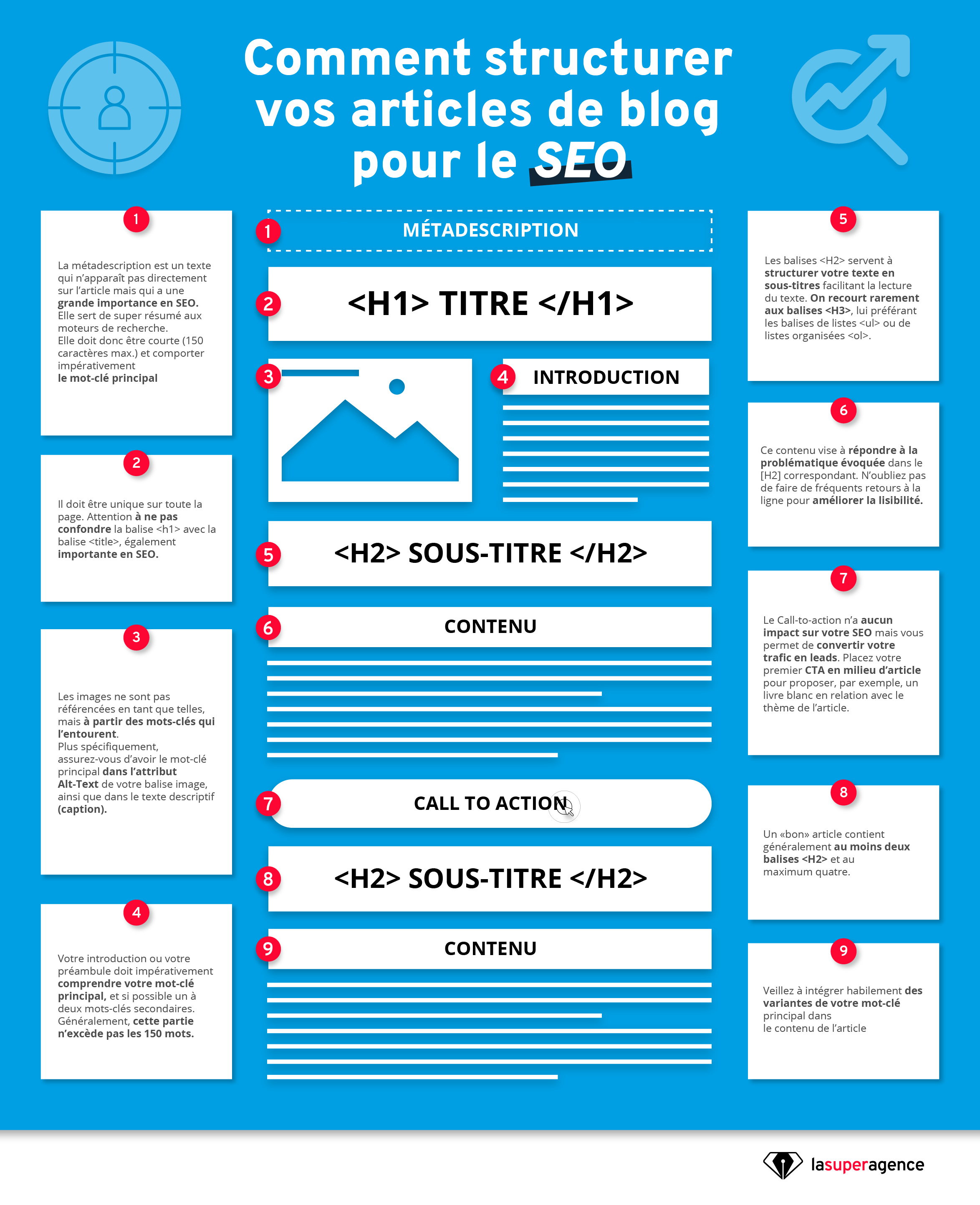Blog posts are at the heart of inbound marketing strategies.
Without a blog, it's impossible to get quality referencing on your business topics and you won't have anything to post that's truly differentiating on social media.
To feed this blog, you will have to write (or have written) many quality articles to interest both your prospects and Google. How to achieve this?
The Super Agency offers you two great infographics to learn how to design the perfect (or almost perfect) article!
Before you write a blog post, you need to know how to write one that will engage your readers and attract the attention of search engines.
There is a writing structure for this to help you achieve both of these goals. This structure is summarized in this infographic:
This infographic provides a simple and effective post writing structure
How to write an effective blog post
1 : Find a catchy title
Your headline is very often the first thing people notice, especially when it's posted on social networks. Know how to give it strength without falling into the " clickbait ". The easiest way is often to ask a question.
2 : Offer a quality first visual
.An image is a good way to break up the monotony of a paragraph. It should suggest a key idea of the article rather than presenting it too obviously. Don't forget to check that your image is copyright free.
3 : Contextualize in the preamble
The preamble is the 2nd gateway to your article after the title. It gives you the opportunity to hook your readers by explaining what they gain from reading what you've written. Be punchy, don't drag it out (two to three sentences maximum).
Remember that a blog post obeys the inverted pyramid structure ! So you answer the question posed in the title right in the introduction. Don't keep your readers waiting. A good half of them will only read this part.
 Get to the point: reveal the essential information directly.
Get to the point: reveal the essential information directly.
5 : Develop your ideas
This is where you will develop the ideas mentioned in the introduction. Each idea corresponds to a paragraph and each paragraph should be preceded by a subheading. You need to optimize your article for your readers and also for search engines.
6: Expand your conclusion
An article is not an essay. You don't need to repeat every point you've made. The conclusion of a blog post is meant to expand on the ideas developed in the post and encourage the reader to continue their research...ideally on your blog.
7 : Appeal to comments
The comment section of your article helps to build a community. So be sure to leave a line at the end of your article to invite your readers to give feedback. Keep it simple " What do you think ? ".
8 : Submit related articles and post on your social networks
This part is part of the recommendation in the conclusion. Use a plug-in or your site's theme to propose similar articles that might interest your readers. Don't forget to respond to any comments you receive and share your article on social networks.
Learn how you can increase your visibility through social media by downloading this free white paper:
How to structure your blog posts for SEO?
As I explained earlier, it's not enough to build an article well to make it engaging for your readers: you also need to make your valuable content easily detectable and indexable for search engines like Google.
Here is a comprehensive infographic on how to achieve effective SEO for your blog post:
How to structure your blog posts for SEO?
1: Metadescription
The meta description is text that does not appear directly on the article, but has great importance in SEO. It serves as a great summary for search engines. It is the text you see first on the page displaying your search results (SERP) on Google.
So it must be short (150 characters maximum) and absolutely include the main keyword.
2: <H1> Title </H1>
It must be unique on the entire page. Be careful not to confuse the tag <h1> with the tag <title>, also important in SEO.
3: Quality visual
Images are not referenced as such, but from the keywords surrounding it.
More specifically, make sure you have the main keyword in the "Alt-text" attribute of your image tag as well as in the descriptive text ("caption").
4: Introduction
Your introduction or preamble should absolutely include your main keyword, and if possible one to two secondary keywords.
Generally, this part does not exceed 150 words.
5: <H2> Subtitle </H2>
The <H2> tags are used to structure your text into subheadings, making the text easier to read.
Tags <H3>are rarely used, preferring list tags <ul> or organized list tags <ol>.
6: Content
This content is intended to respond to the issue raised in the corresponding <H2>. Remember to make frequent line breaks to improve readability.
7: Call to action
The call to action has no impact on your SEO but allows you to convert your traffic into leads.
Place your first CTA in the middle of the article to offer, for example, a white paper related to the article's theme.
8: <H2> Subheading </H2>
A "good" article usually contains at least two <H2> tags and no more than four.
9: Content
Be sure to cleverly incorporate variations of your main keyword into the article's content.
Writing a good article is a lot like driving.
You can study the rules of the road for months, it doesn't mean you're going to be able to handle yourself once you're behind the wheel.
There is no substitute for practice!
So grab your best pen and start writing. In time, you'll be able to write an article like a pro!










